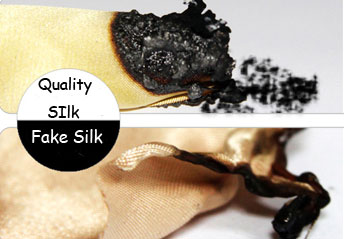Silk Identification
How To Tell Genuine Silk From Fake Silk?
It seems that more and more silk fabrics are appearing in the market. Customers have big doubts about its purity when they want to buy 100% natural silk home. Therefore, there are a number of ways for reference which can be used together to try to determine if a fabric is genuine silk or a synthetic man-made fabric that looks like silk.
Price
It is the easiest way to tell pure silk from others. Genuine and high-quality silk will always be relatively expensive. Synthetic fibres like polyester can be made to look like real silk to the untrained eye. Although synthetic fabrics can be deliberately priced high, low prices usually indicate the fabric is not genuine silk. Real silk usually costs at least ten times as much as synthetics to produce.
Lustre
Silk Lustre is different from other fabrics. It is shimmering. The shimmering appearance of silk is due to the triangular prism-like structure of the silk fiber, which allows silk cloth to refract incoming light at different angles, thus producing different colors. This “shot” effect gives a surface that “shines” and appears to change color as the angle of light on it changes. Synthetic fabrics shine white, no matter what the angle of the light.
Weave
Silk can be hand-woven or machine-woven. Hand-woven silk has its own individual characteristics. Each piece is unique. Look for slubbing, and slight, very minor variations in the evenness of the weave. These are natural and to be expected. Machine-woven silk will have a perfectly even weave with no flaws and very little character.
Synthetic fabrics will mostly also look perfect, although very few artificial fabrics are made to look very realistic, including slubbing and slight imperfections.
Pattern
Genuine silk with a printed pattern (not the same as a woven pattern) will have the pattern visible on one side and an outline of the pattern on the reverse side. Genuine silk with a woven pattern will have the pattern visible on both sides but the pattern on the reverse side may appear slightly “fuzzy”.
Synthetic fabrics with a printed pattern will have the pattern visible on one side and a plain color on the reverse side.
Hand Touch
Smoothness! Touch it by hand, and feel the smoothness. Soft, waxy feeling is unique characteristic of silk products. When pressed on the surface of the product, a pulling feeling will be created. If there is no such feeling from the product, it should not be the real silk.
Friction
Mutual friction of silk products will create a crisp sound, commonly known as wire-ming. If there is no wire-ming phenomenon, it is not real silk fiber silk.
Burn Test
 This is not a standard test performed on silk! However, it is a fairly definitive test.
This is not a standard test performed on silk! However, it is a fairly definitive test.
Extracted from the fabric edge off a bunch of silk yarn, lit with a match. The bunch of Silk burn slowly with faint glow. Firstly, it will curl into a ball with a similar smell of burning human hair or bird hair. Then, after burning into the dark brown globular, once you touch the globular,it will be broken into powder. Finally, when leaving the flame, it stops burning immediately. The burning silk should smell like burning hair. (Both substances mainly consist of a fibrous protein–fibroin in the case of silk and keratin in the case of hair.)
A synthetic fabric will burn with a smell like burning plastic and will drip, form a black ball of residue (not ash), and produce black smoke. It will continue to burn even after the flame is taken away.
ATTENTION PLEASE! The reaction of the burn test on silk thread is very similar to the reaction of the same test with wool yarn. Make sure that there is a bucket of water closing by. Some fabrics that look like silk are actually extremely flammable and will need to be doused immediately.
More about how to identify real silk
No Authors Are Currently Enabled
Tick the "Show On About Us Page Template" checkbox on each author profile you wish to showcase here.
